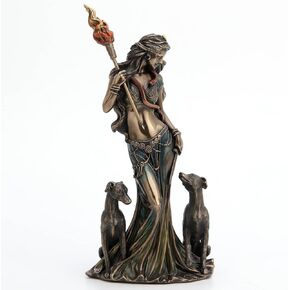- Shopping, made easy.
- /
- Get the app!
The St. Benedict Crucifix is a powerful Catholic sacramental that combines two important symbols: the crucifix and the St. Benedict Medal. The crucifix represents the sacrifice of Jesus Christ on the cross, while the medal features an image of St. Benedict of Nursia, a 6th-century monk who is well-known for his teachings on spiritual warfare and protection from evil. The medal, embedded in the crucifix, contains various inscriptions and symbols, most notably a Latin cross with the letters "C S S M L - N D S M D," which stand for "Crux S. Sit Mihi Lux! Non Draco Sit Mihi Dux!" This translates to "May the Holy Cross be my light! Let not the dragon (devil) be my guide!" Around the outer edge of the medal, the words "Eius in obitu nostro praesentia muniamur" can be found, which means "May we be protected by his presence at the hour of our death." Additionally, the medal has other symbols such as the St. Benedict's monogram ("Pax" or "peace") and images of a poisoned chalice and a crow – both referring to legends where St. Benedict survived attempts on his life. The St. Benedict Crucifix is often used as a means of protection against evil and temptation, as well as a reminder of the power of Christ's sacrifice on the cross. It can also be used in exorcisms due to its association with St. Benedict and his focus on spiritual warfare. Overall, the St. Benedict Crucifix serves as a powerful reminder of faith, encouraging spiritual growth and invoking protection against evil influences. It is a popular sacramental among Catholics, often worn as a pendant or displayed in homes and other places as a symbol of faith and devotion.
 Veronese Design 12.5" Tall Steampunk Owl Pendulum Wall Clock Cold Cast Resin Antique Bronze Finish Wall Sculpture
KWD 28.500
Veronese Design 12.5" Tall Steampunk Owl Pendulum Wall Clock Cold Cast Resin Antique Bronze Finish Wall Sculpture
KWD 28.500
 Veronese Design 13 3/8" Hecate Greek Goddess of Magic with her Hounds Resin Sculpture
KWD 35.500
Veronese Design 13 3/8" Hecate Greek Goddess of Magic with her Hounds Resin Sculpture
KWD 35.500
 Veronese Design 4.5 Inch Genesis The Creation of Adam Sistine Chapel Michelangelo Great Art Religious Antique Bronze Statue
KWD 28
Veronese Design 4.5 Inch Genesis The Creation of Adam Sistine Chapel Michelangelo Great Art Religious Antique Bronze Statue
KWD 28
 Veronese Design 7 3/4 Inch Kali Hindu Goddess Standing On Lord Shiva Cold Cast Resin Bronze Finish Statue
KWD 30
Veronese Design 7 3/4 Inch Kali Hindu Goddess Standing On Lord Shiva Cold Cast Resin Bronze Finish Statue
KWD 30